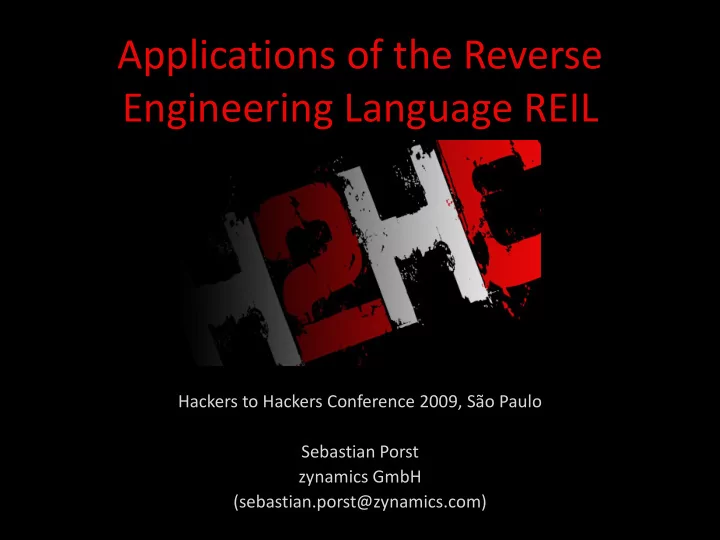

Applications of the Reverse Engineering Language REIL Hackers to Hackers Conference 2009, São Paulo Sebastian Porst zynamics GmbH (sebastian.porst@zynamics.com)
Talk Overview • Necessity of new RE methods • Solutions we developed • Applications of our solutions
About zynamics • Small German company • Unhappy with the state of Reverse Engineering • Needed: New RE tools and methods – BinDiff, BinNavi, VxClass
About me • Lead Developer of BinNavi • Many years of RE experience • Try to come up with new RE methods • Talk about it at conferences
What we are doing • Build Reverse Engineering tools • Try to automize binary file analysis • Help people find vulnerabilities
Why we are doing this Software Complexity Architectural Diversity Microsoft Security Budget Good old days Now
How we are doing this • Develop new RE methods – Platform-Independent – Easy to use • Integrate them into our tools
REIL • Reverse Engineering Intermediate Language • Platform-Independent • Designed for Reverse Engineering
Design Principles • Very small instruction set • Very regular operand structure • Very simple operand types • No side-effects
Example
REIL Usage Convert native code to REIL Run REIL algorithm Port results back to original code
Advantages • Easy to pick up and comprehend • Reduces analysis complexity • Write once; use everywhere
MonoREIL • Monotone framework for REIL • Simplifies analysis algorithm development • Read the book
Advantages • All algorithms have the same regular structure • Simplifies algorithms – Trade-off: Runtime
Core Concepts • Instruction Graph • Lattice • Monotone Transformations
Instruction Graph 1400: add t0, 15, t1 1401: bisz t1, , t2 1402: jcc t2, , 1405 1403: str 8, , t3 1405: str 16, , t3 1404: jcc t2, , 1406 1406: add t3, t3, t4 1407: jcc 1, , 1420
Lattice T B
Transformations 1400: add t0, 15, t1 1401: bisz t1, , t2 1402: jcc t2, , 1405 1403: str 8, , t3 1405: str 16, , t3 1404: jcc t2, , 1406 1406: add t3, t3, t4 1407: jcc 1, , 1420
Applications Register Tracking : Helps Reverse Engineers follow data flow through code (Never officially presented) Index Underflow Detection : Automatically find negative array accesses (CanSecWest 2009, Vancouver) Automated Deobfuscation : Make obfuscated code more readable (SOURCE Barcelona 2009, Barcelona) ROP Gadget Generator : Automatically generates return-oriented shellcode (Work in progress; scheduled for Q1/2010)
Register Tracking • Follows interesting register values • Keeps track of dependent values • Transitive closure of the effects of a register on the program state
Lattice All eax eax ebx ecx ebx ecx ecx OF eax ebx ecx OF Ø
General Idea • Start with the tracked register • Follow the control flow • Instruction uses register → Add modified registers to the tracked set • Instruction clears register → Remove cleared register from the set
Example {t0} add t0, 4, t1 {t0, t1} bisz t2, , CF {t0, t1} bisz t0, , ZF {t0, t1, ZF} add t2, 4, t1 {t0, ZF}
Result
Use • Fully integrated into BinNavi • Makes it very simple to follow values • Helps the reverse engineer to concentrate on what is important
Range Tracking • Tracks potential ranges for register values • Useful to detect buffer underflows like MS08-67 • Intervals are used to cut down on complexity
Lattice • Complicated to show in a picture • Keep track of register values and pointer dereferences as a list of ranges • eax [0 .. 4] [0 .. 10] – Add a value between 0 and 10 to [eax], [eax + 1], [eax + 2], [eax + 3], or [eax + 4]
General Idea • Track register values relative to their first use • Follow the control flow • Calculate maximum range of effects each instruction has on a register • If the range gets negative for memory accesses, mark the location
Use • Helps bug hunters to find potential vulnerabilities • Automated and effective • Not yet fully proven to work
Deobfuscation • Convert obfuscated code into something more readable • Multi-process step with many lattices – Constant propagation – Dead code elimination – ...
General Idea • Take a piece of code • Apply the deobfuscation algorithms • Repeat until no further deobfuscation is possible • Result: Deobfuscated Code
Result Before After
Problems • Turns out that deobfuscation is tricky for many reasons • Further requirements: – Function that determines the readability of code – Backend that produces executable code from REIL
ROP Gadget Generator • Return-oriented shellcode generator • REIL-based but not MonoREIL-based • Originally for Windows Mobile but platform-independent • To be presented in 2010
General Idea • Automated analysis of instruction sequences • Automated extraction of useful instruction sequences • Combines gadgets to shellcode • Helps the development of return- oriented shellcode
Result
Future Development • BinAudit – Collection of algorithms for vulnerability research • Type Reconstruction – Figuring out what higher level data types are stored in registers
Related Work • ERESI Project • BitBlaze • Silvio Cesare
http://www.flickr.com/photos/marcobellucci/3534516458/
Recommend
More recommend